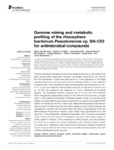Please use this identifier to cite or link to this item:
http://www.alice.cnptia.embrapa.br/alice/handle/doc/1032807| Title: | Genome mining and metabolic profiling of the rhizosphere bacterium Pseudomonas sp. SH-C52 for antimicrobial compounds. |
| Authors: | VOORT, M. van der  MEIJER, H. J. G.   SCHMIDT, Y.   WATROUS, J   DEKKERS, E.   MENDES, R.   DORRESTEIN, P. C   GROSS, H.   RAAIJMAKERS, J. M.   |
| Affiliation: | MENNO VAN DER VOORT, Wageningen University; HAROLD J G MEIJER, Wageningen University; YVONNE SCHMIDT, University of Bonn; JERAMIE WATROUS, University of California; ESTER DEKKERS, Wageningen University; RODRIGO MENDES, CNPMA; PIETER C DORRESTEIN, University of California; HARALD GROSS, University of California; JOS M RAAIJMAKERS, Wageningen University. |
| Date Issued: | 2015 |
| Citation: | Frontiers in Microbiology, Lausanne, v. 6, 2015. Article 696. |
| Pages: | 14 p. |
| Description: | Abstract: The plant microbiome represents an enormous untapped resource for discovering novel genes and bioactive compounds. Previously, we isolated Pseudomonas sp. SH-C52 from the rhizosphere of sugar beet plants grown in a soil suppressive to the fungal pathogen Rhizoctonia solani and showed that its antifungal activity is, in part, attributed to the production of the chlorinated 9-amino-acid lipopeptide thanamycin (Mendes et al., 2011). To get more insight into its biosynthetic repertoire, the genome of Pseudomonas sp. SH-C52 was sequenced and subjected to in silico, mutational and functional analyses. The sequencing revealed a genome size of 6.3 Mb and 5579 predicted ORFs. Phylogenetic analysis placed strain SH-C52 within the Pseudomonas corrugata clade. In silico analysis for secondary metabolites revealed a total of six non-ribosomal peptide synthetase (NRPS) gene clusters, including the two previously described NRPS clusters for thanamycin and the 2-amino acid antibacterial lipopeptide brabantamide. Here we show that thanamycin also has activity and affects phospholipases of the late blight pathogen Phytophthora infestans. Most notably, mass spectrometry led to the discovery of a third lipopeptide, designated thanapeptin were found with varying degrees of activity against P. infestans. Of the remaining four NRPS clusters, one was predicted to encode for yet another and unknown lipopeptide with a predicted peptide moiety of 8-amino acids. Collectively, these results show an enormous metabolic potential for Pseudomonas sp. SH-C52, with at least three structurally diverse lipopeptides, each with a different antimicrobial activity spectrum. |
| Thesagro: | Rizosfera Bactéria Pseudomonas sp Peptídeo Beterraba Controle biológico |
| NAL Thesaurus: | Beneficial microorganisms Rhizosphere bacteria Antimicrobial peptides Sequence analysis Mass spectrometry Biological control |
| Keywords: | Pseudomonads Genomes sequencing Biocontrol |
| Type of Material: | Artigo de periódico |
| Access: | openAccess |
| Appears in Collections: | Artigo em periódico indexado (CNPMA)  |
Files in This Item:
| File | Description | Size | Format | |
|---|---|---|---|---|
| 2015AP29.pdf | 2,57 MB | Adobe PDF |  View/Open |









